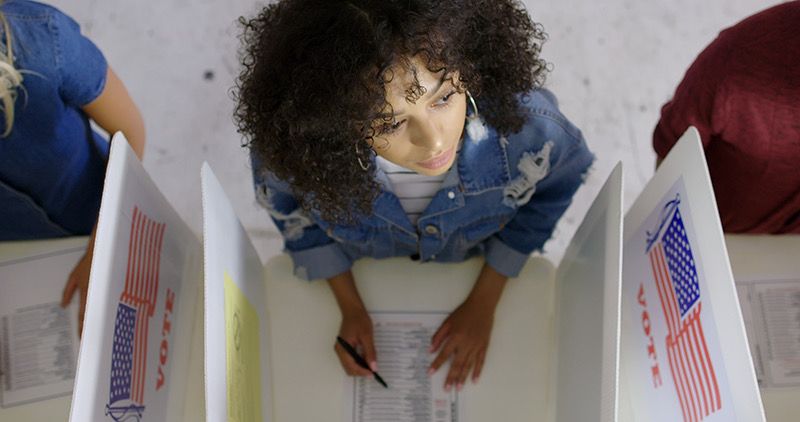Diverse Perspectives on Ethnic and Women’s Votes, Voter Access, and Redistricting
Partial mid-term results may not be enough to draw firm conclusions about these elections, but an Ethnic Media Services briefing, Nov. 11, experts – Sergio I. García-Rios, Assistant Professor, Associate Director for Research, Center for the Study of Race and Democracy, the University of Texas at Austin; Christine Chen, Executive Director of Asian Pacific Islander American Vote (APIAVote); Karma Cottman, Executive Director of Ujima Inc.: The National Center on Violence Against Women in the Black Community; Gowri Ramachandran, Senior counsel, Brennan Center’s Elections & Government Program; and Kathay Feng, Common Cause, Director of Redistricting and Representation – analyze the voting trends among Latino, AAPI, Black voters, election security issues, and the impact of gerrymandered maps on voters of color.

The surprising midterm elections that we just had, with results that are still developing, but that already have become the most atypical midterm election in decades.
Historically, midterm elections are a sweep for the party not in the White House. For the last four or five presidents, a midterm always meant losing dozens of House seats and sweeping defeats across the board.
It happened to Trump; to Obama; to Bush; to Clinton; but this did not happen this time.
At the time of this event, the Senate is still in play, though at the time of publishing this article, the Senate looks firmly in the grasp of Democrats.
Even though Republicans have an advantage in the house and, they seem to be on the course to retake the majority, their gains could be the smallest in a generation and not large enough to give them a mandate of any kind.
Why didn’t it happen and what voters had a hand in stopping the so-called red wave that never materialized? How did voters of color and women vote and what motivated them? and how did redistricting voting access and disinformation play a role?
Sergio I. García-Rios, based on his research, spoke about who were the voters that stopped the Red Wave.
“Every mid cycle, every midterm election, the party who occupies the White House loses votes. This is the natural trend that has been trending historically. There’s been only a few exceptions.
“We also had a president that is very unpopular, and then, an economy that’s struggling.
“The voters might not fully understand inflation. What they do understand is the prices that they pay at the supermarket and gas station, so affordability was an issue.
“All of that made for a perfect combination of factors that will lead into a red wave. We did four polls, one in Nevada; one in Arizona; one in Florida; one in Texas; and all these show that people of color and non-Hispanic whites were very concerned about the economy.
“A second concern in all our polls were gun safety; mass shootings; and security along the border. People were concerned about crime but not necessarily about immigration or border control,” said García-Rios.
Christine Chen shared her takeaway on the results in the AAPI vote.
“It looks like that Democrats are still getting the majority support but there is some slippage with that. We also know that it also varies according to the Asian ethnicity. When you look at the 2022 Asian American voter survey that we conducted early on, we had noticed that there’s an increasing number of independent voters among the Asian-American electorate.
“The Chinese have the largest percentage of Independents at 47 percent. The Vietnamese who support Republicans at a higher rate than any other Asian ethnic group are losing party identification to Independents.
“The Gen Z and Millennials leaning in, registering, and voting, and coming of age, change the demographics of the overall AAPI electorate, which tends to be a little bit older at this point,” said Chen.
Karma Cottman shared her take on the midterms, especially for black women voters.
“People tend to vote in their party, or not vote at all, because they just completely feel disengaged by politics. What we saw in the black community for black women was mobilizing to get out the vote. What that meant was really going into community, figuring out how to mobilize and how to ensure that our issues were represented at the polls,” said Cottman.
Gowri Ramachandran addressed the threats and disinformation that was highlighted at some of the polls.
“There was reason for people to be concerned about intimidation, disinformation, about the results, and the reason that was understandable is primarily what we saw in the aftermath of the 2020 election.
“It’s understandable for people to be concerned that there might be a repeat of some of those efforts, especially efforts to undermine free and fair results; but there was also a growing election denier movement of people, going out and trying to convince citizens.
“The Brennan Center conducted a poll in the spring of this year and found that one in six local election officials had been personally threatened over this kind of behavior.
“A lot of effort was put in to keep the system safe and keep it resilient and ensure that people could vote with confidence.
“The Maricopa incident where some of the machines were not accepting the ballots, there was already a resiliency measure in place which is that there’s a slaw on the side of the machine where the voters can place and it will be secure their ballot and then that later can be taken out and fed into a scanner that’s going to accept it and count it at the end of the day,” said Ramachandran.
Kathay Feng spoke on how candidates of color faired after the redistricting process, “There are about seven states that have relatively independent commission and another six states that have advisory commissions, about 13 states, that have independent commissions. There are three states where they were drawn by truly independent, non-politician commissions that were not chosen by politicians in the state. Those three states where California, Colorado, and Michigan.
“It’s significant to note that in each of these states there have been tremendous participation by communities of color to come out and talk about where those communities are; to talk about the growth; and to make sure that the lines are truly reflective of those communities.
“You don’t see that in states where the redistricting is controlled by incumbents and politicians where despite the tremendous growth of Latino populations in States like Texas, or the significant black population in Florida, those communities were sliced and diced up so that the growth was not represented or the historic representation was essentially dismantled,” said Feng.
Swati Joshi from Desi Blue said, “A lot of women in Texas spoke about ‘Roe vs Wade’ and gun legislation. The two topics that are concerning women because Uvalde had occurred this year and it’s been very scary for moms to send their kids off to school, and be concerned, ‘will they see them again?’


